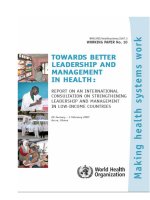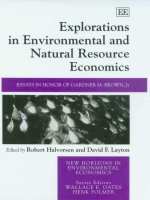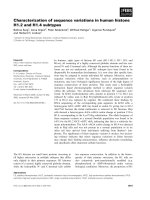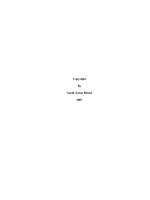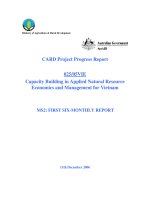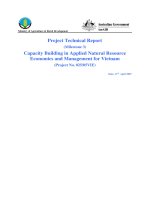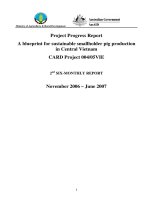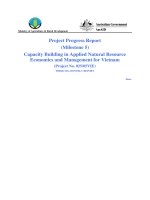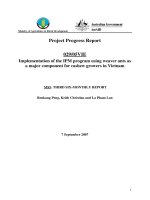Project Technical Report: " Capacity Building in Applied Natural Resource Economics and Management for Vietnam " ppt
Bạn đang xem bản rút gọn của tài liệu. Xem và tải ngay bản đầy đủ của tài liệu tại đây (2.9 MB, 67 trang )
Ministry of Agriculture & Rural Development
Project Technical Report
(Milestone 3)
Capacity Building in Applied Natural Resource
Economics and Management for Vietnam
(Project No. 025/05VIE)
Date: 11
th
April 2007
Contents
Institute Information
1
Project Abstract
2
Introduction
3
1. Competency Assessment and Curriculum Development
3
2. Farmer Surveys
4
3. Agricultural Knowledge Information System Website
Implementation Plan
5
4. Policy Briefs
7
5. Sign-off 15
List of Annexes
Annex 1 Competency Questionnaire, Training Workshop on Natural
Resource Economics and Management
16
Annex 2
Farmer Survey Report 18
Annex 3
Web Page Contents of the Agricultural Knowledge
Information System Website
60
- 1 -
Institute Information
Project Name
Capacity Building in Applied Natural Resource
Economics and Management for Vietnam
Vietnamese Institution
Faculty of Economics and Rural Development,
Hanoi Agricultural University
Gialam, Hanoi, Vietnam
Vietnamese Project Team Leader
Mr. Tran Dinh Thao
Australian Organisation
Faculty of Agriculture, Food and Natural Resources
University of Sydney, NSW, 2006, Australia
Australian Personnel
Emeritus Professor Thomas Gordon MacAulay
Date commenced
January 1, 2006
Completion date (original)
June 30, 2008
Completion date (revised)
Reporting period
Contact Officer(s)
In Australia: Team Leader
Name:
Prof. Thomas Gordon
MacAulay
Telephone:
61 2 9888 9600
Position:
Emeritus Professor
Fax:
61 2 9888 5821
Organisation
Faculty of Agriculture, Food
and Natural Resources
University of Sydney, NSW
2006, Australia
Email:
In Australia: Administrative contact
Name:
Ms. Luda Kuchieva
Telephone:
61 2 9351 7903
Position:
Administration officer
Fax:
61 2 9351 3256
Organisation
Research Grants
University of Sydney,
NSW 2006, Australia
Email:
In Vietnam
Name:
Mr. Tran Dinh Thao
Telephone:
84 48 769 770
Position:
Senior Lecturer, Head of
Department
Fax:
84 48 276 554
Organisation
Faculty of Economics and Rural
Development
Hanoi Agricultural University
Gialam, Hanoi, Vietnam
Email:
Or
- 2 -
Project Abstract
With very rapid growth and development in Vietnam, there is a danger of overuse and
mismanagement of natural resources, thus compromising sustainable development.
The level of knowledge, understanding and use of the principles of natural resource
management (NRE) is limited in Vietnamese agriculture. The designed outcome of
the project is to begin to have resource management concepts used in various
institutions in Vietnam (Universities, MARD, and the extension system) and to
strengthen the ability to deliver knowledge, set policies and advise farmers in this
area. This outcome is being approached through a participatory approach using
workshops in Vietnam on NRE held by the University of Sydney staff and the staff of
the participating organizations. Two training workshops and extension workshops
each have already been held in Hanoi and Can Tho, Vietnam. Two of the Vietnamese
scholars have had three month visits to the University of Sydney so as to broaden their
understanding of NRE. In the next stage, three more extension workshops will be held
at the provincial level by Vietnamese staff with participation of USYD team
members, thus transferring the acquired knowledge to extension specialists and
thereby to smallholder farmers. In the final stage, five training workshops/field days
with farmers will be conducted to demonstrate the use and application of practical
knowledge and skills in resource management.
- 3 -
Introduction
This report has been prepared as a part of the project milestone three, which includes;
1. The baseline for a natural resource economics curriculum at Hanoi
Agricultural University (HAU) and Can Tho University and an assessment of
the competency and knowledge levels of university faculty staff in natural
resource economics and the available information.
2. Farmer surveys and priorities for farmer intervention in natural resource
economics.
3. Documentation of an Agricultural Knowledge Information System including
details of the website and an implementation plan agreed to by HAU and Can
Tho University.
4. Policy briefs based on the research work of two Vietnamese research scholars.
1. Competency Assessment and Curriculum Development
This project was designed to strengthen the teaching and research capacity in the field
of natural resource economics in several key Vietnamese institutions of higher
education. This is being accomplished through assistance in curriculum development
and course design and transfer of research and training expertise.
The first stage of the project, that is, institutional capacity building has been
approached through conducting training workshops on Natural Resource Economics
and Management run by staff of The University of Sydney in Hanoi and Can Tho.
Assistance was also provided by a group of academics at Hanoi Agricultural
University (there were 26 participants), and Can Tho University (there were 19
participants) in July 2006. The aim of the workshops was to enhance the capacity of
the participants to pass on the acquired knowledge to extension specialists. Pre and
post workshop competency tests were conducted among the participants to compare
their knowledge level before and after the workshops. The results were very
satisfactory; in the post workshop competency tests (Refer to Annex 1).
The curriculum development part of the project for the Vietnamese Institutions is
currently in progress. Issues of curriculum and course design have been discussed at
both of the Vietnamese institutions visited by the University of Sydney team
- 4 -
members. In Hanoi they met with Dr. Thuy, a lecturer at Hanoi Agricultural
University who teaches the unit Environmental Economics (January 2006). We had a
very good discussion and reviewed the curriculum for the unit. The unit content was
reasonably standard, with an emphasis on theoretical concepts. Even though these
concepts are important and useful in grasping the problems of environmental
economics, it was mutually agreed that the curriculum for this unit could benefit from
incorporating more practical activities. These included: exercises based on custom
built MS-Excel spreadsheets, analysis and discussion of research papers, short essays
on certain aspects of environmental and resource economics, etc. It was agreed to
consider the specific areas of environmental and resource economics that will be
covered in this project and to make them available to Dr. Thuy.
In Can Tho a meeting was held with Ms. Vo Thi Lang, a lecturer in environmental
economics at Can Tho University, with whom collaboration in reviewing curricula
was discussed for the subjects that she was teaching. Work is continuing on
identifying the curriculum needs for Environmental and Resource Economics at Can
Tho University.
2. Farmer Surveys
The initial information for a stakeholder/beneficiary analysis of the project was
collected by holding extensive discussions in Vietnam and by administering a survey
on small groups of identified potential stakeholders in Vietnam (refer to the project
proposal for a summary of the results of this survey).
A more detailed stakeholder/beneficiary analysis using a participatory approach with
a focus on smallholder farmers was planned as one of the first activities within this
project which would help to identify the key concerns and needs that the farmers have
in relation to the natural resources. The farmer survey has been completed with a total
of 90 respondents. 15 participants each were interviewed from Bac Giang, Bac Lieu,
Hung Yen and Soc Trang regions and another 30 participants were interviewed from
Ha Tinh region. The possible key interventions, as identified from the farmer survey
are given below.
- 5 -
Possible Key Interventions
Water issues appear to raise serious concerns among the sampled farmers, suggesting
that improvements in irrigation and drainage systems are high on the list of key
interventions. (Where irrigation systems exist, high fees have been raised as a
concern.) Water quality is also an issue, with water pollution being identified as a
constraint on shrimp farming. Water treatment facilities may be a possible area for
policy intervention. Declining fish stocks were also identified as a major problem,
meaning that regulatory intervention in the open access fishing industries is in urgent
need of various forms of policy mechanisms to manage the stocks.
Regarding terrestrial farming, unclear farm boundaries and uncontrolled ruminant
grazing suggest the importance of clarifying property rights, so that use of on-farm
resources can be more efficiently (and sustainably) managed by the property owner.
It is also notable that in two surveyed provinces (Soc Trang and Bac Lieu) less than
10 per cent of the sampled farmers had access to agricultural extension services. The
issue of availability of extension services in those areas should be addressed. Fuller
details are provided in the attached farmer survey Report in Annex 2.
3. Agricultural Knowledge Information System Website Implementation Plan
The creation of the Agricultural Knowledge Information System (AKIS) website was
first proposed by the project participants during the project inception meeting in
January, 2006 and again during the first round of workshops in July, 2006. The key
issues identified were in relation to hosting the website, securing an appropriate
domain name, general design features and content, and web administration issues. The
project team appointed Mr. Nguyen Duy Linh of Hanoi Agricultural University as a
website administrator with the primary responsibility of setting up, maintaining and
updating the website. This was deemed appropriate, since administering the website in
Vietnam and by a Vietnamese team member was seen as a valuable contribution to
the capacity building objective of the project. It was also decided that Ms. Annette
Vervoort of The University of Sydney, will act as a web administrator and she will be
responsible for uploading materials provided by the Australian team members.
- 6 -
Current status
The website domain name is
www.resman.edu.vn and is currently operational in an
initial version and is temporarily hosted on the HAU server. It consists of both
Vietnamese and English components. The website has been publicised in the recent
round of workshops. The website target audience is Vietnamese academics and
students in the area of natural resource and environmental economics, policymakers in
this area (MARD), extension workers and farmers with some expertise in the area.
Currently, the website contains the description of the Projects, the materials from the
first round of workshops (Powerpoint presentations), as well as useful links to internet
resources.
Actions to be taken
Updating the website contents with new material needs to be expedited, and its usage
needs to be encouraged through publicising its existence. The following steps have
been agreed upon:
1. Uploading the most recently available material flowing from the project (workshop
materials, research papers by research scholars, workshop schedules and programs,
further links, photos, etc.). This will be undertaken by Mr. Linh and Ms. Vervoort. It
is expected that the website will be fully functional by the end of 2007 with all
materials and resources being posted and organised along with easy accessibility.
2. Further publicity for the website will be provided through e-mails sent to relevant
institutions and agencies in Vietnam during the December 2007 to January 2008
period.
3. Usage of the website and the active involvement of the project partners, Hanoi
Agricultural University, CanTho University and Hue University, will be encouraged
through a letter from the project leaders, Gordon MacAulay and Tran Dinh Thao.
These letters will be sent to people and departments in the three participating
universities and some other related organisations. This step will help inform potential
users about the existence and functionality of the website and encourage further
dissemination of the website address, in particular, to extension agencies and officers
(details of the website are provided in Annex 3).
- 7 -
4. Policy Briefs
Two policy briefs have been prepared based on the research work of the two research
scholars (Ms. Do Thi Den, Can Tho University and Ms. Le Thi Kim Lien, Hue
Economics University). The research scholars arrived at The University of Sydney in
July and completed their research projects related to the development of case studies
in resource use in Vietnam. Ms. Do Thi Den, who arrived on 22
nd
July and departed
on 22
nd
October 2006, carried out research entitled “The Efficiency of Prawn
Production in the Mekong Delta”. Similarly, Ms. Le Thi Kim Lien, who arrived on
27
th
August and departed on 1
st
Nov 2006, undertook a research project entitled
“Alternative Systems of Shrimp Culture in the Lagoon Area of Thua Thien, Hue,
Vietnam”. Ms Den prepared a paper and which was presented at the Australian
Agricultural and Resource Economics Conference, held in Queenstown, New Zealand
in February 2007 and this was used as the basis for the policy brief entitled “The
Efficiency of Prawn Production in the Mekong Delta.” The policy brief relating to
Ms Lien’s work was entitled “Alternative Systems of Shrimp Culture in the Lagoon
area of Thua Thien, Hue, Vietnam.” Both briefs identified the CARD project 025/05
VIE and points of contact in relation to the work. These will be made available on the
website and are provided below.
- 8 -
Policy Brief (1)
AusAID CARD Project 025/05 VIE
The Efficiency of Prawn Production in the Mekong Delta
Purpose
To provide an update for relevant decision makers on recent information collected and
analysed regarding the efficiency of production for prawns in the Mekong Delta, and
on some factors which affect the efficiency.
Background
Prawn farming has developed very rapidly as an industry in the Mekong Delta to the
point where it supplies 60 per cent of the value of Vietnam’s annual aquatic products
exports and some 29.2 per cent of the agriculture sector’s contribution to gross
national product. However, over the period 2003-5 some 30 per cent of the total
prawn farms were experiencing economic losses (Sinh 2006) reflecting the high levels
of risk involved and particularly the risk of disease outbreaks. The profitability of
prawn farms depends to a considerable extent on their productivity.
Economic efficiency has two components: technical efficiency and allocative
efficiency (Farrell 1957). Technical efficiency reflects the ability of a farm to obtain
maximum output from a given set of inputs using the available technology (Dey et al.,
2000). The levels of technical efficiency of 193 prawn farms from Bac Lieu province
were analysed. A stochastic frontier model was used to determine the technical
efficiency of each farm in the production of prawns. Then, a second regression model
was run, using the technical efficiency measures and data on the characteristics of the
households and farms, to determine which factors were most likely to influence the
level of technical efficiency for a household.
Issues
• Land, and to some extent water resources, are very limited in Vietnam so that their
efficient use is important to the economic growth and development of the country.
• Prawn farming is a new and expanding industry in the Mekong Delta. The
importance of measuring the level of technical efficiency of prawn aquaculture
- 9 -
production lies in the need to ensure that scarce resources (land and water) are being
used efficiently and that farmers are making good returns in this activity.
• Once measured, the key issue is: what are the factors that determine or vary with the
level of efficiency of resource use. Clearly some of these factors can be controlled
or managed to the advantage of the farmers and the economic development of
regions.
Findings
Data from 193 households with prawn farms in Bac Lieu Province were collected in
2004. On average, the surveyed farmers (head of household) had completed five years
of education, and those operating intensive operations generally had a slightly higher
level of education. Those with intensive operations had smaller households. The
average farm area for intensive farms was 1.2 hectares and 1.74 hectares for the
extensive farmers. The average years of experience in prawn farming was 4 years and
5 years for intensive and extensive prawn farms respectively. However, a large
portion of intensive prawn farmers had very little or no experience in prawn farming.
The average net income of the intensive operators (VND 60 million) was much higher
than that of the extensive operators (VND 10 million). This is the result of yield
being about eight times higher and the production costs being about nine times higher
in intensive as compared to extensive operations. Intensive prawn farming was more
profitable on average; however, there was about 37 per cent of both types of farmers
with negative profits. A small number of the farmers (7 per cent) gained very high
profits of over VND 200 million. Intensive farming dominated both the categories of
very high profits and very high losses.
The average productivity of prawn farms in Vietnam was investigated in a recent
survey, and was reported to be 150 kg/ha/year in extensive farming up to 6,000 –
10,000 kg/ha in the case of intensive farming practice (Estelles et al., 2002). This can
be compared to overall averages of prawn farm productivity levels in some of the
major prawn producing countries like Thailand (3,116 kg/ha), Malaysia (1,500 kg/ha),
China (800 kg/ha), Philippines (770 kg/ha) and India (635 kg/ha) (Kumar et al.,
2004).
- 10 -
Using the stochastic frontier approach, levels of efficiency were obtained and it was
found that labour use, seed (fingerlings), and feed use were the important variables
driving production. The estimated technical efficiency ranged from zero to 90 per
cent with a mean of 46 per cent. Thus, on average prawn farmers were producing at
about 46 per cent of their possible efficiency (intensive 35 per cent and extensive 48
per cent). These efficiencies were lower than those estimated in India (Kumar et al
2004) and the Philippines (Dey et al 2000).
Considering the factors that affect efficiency, it was found that the more experienced
growers and the younger growers were generally technically more efficient, but that
the higher educated were less efficient. It is likely that better educated but much less
experienced farmers are managing the intensive farms. This type of operation requires
greater skills to run and thus it is more difficult to achieve high level of efficiency and
profitability.
Policy Implications
1. There is clearly scope to significantly raise the technical efficiency of prawn
farming in the Mekong Delta area.
2. There is a basic lack of experience and knowledge about prawn farming in the
Delta given the rapid rise of this industry so that investment in training and
knowledge provision is urgent.
3. Prawn farming in the Mekong Delta is currently a risky business so that the
efficient management of inputs is important if the risk is to be reduced. This will
involve improved knowledge and skills in using inputs of feed, seed and labour so
as to avoid disease outbreaks and other risk factors.
References
Dey, M.M., Paraguas, F.J., Bimbao, G.B. and Regaspi, P.B., 2000, ‘Technical efficiency of Tilapia growout pond
operations in the Philippines’, Aquaculture Economics and Management, vol 4, pp. 33-47.
Estelles, P., Jensen, H. and Sanchez, L., 2002, Sustainable Development in the Mekong Delta, Centre for
Environmental Studies, University of Aarhus, Denmark.
Farrell, M.J., 1957, ‘The measurement of productive efficiency’, Journal of the Royal Statistical Society, Series A
(General), vol 120, no 3, pp. 253-290.
Kumar, A., Birthal, P.S. and Badruddin, 2004, ‘Technical efficiency in prawn farming in India: estimation and
implications,’ Indian Journal of Agricultural Economics; vol 59, no. 3, pp. 413-420.
- 11 -
Sinh, L. X., 2006, Major considerations on the fishery sector in the Mekong Delta of Vietnam, Presentation to the
CARD workshop, Can Tho, Vietnam, July 15-20, 2006.
More information may be obtained from: Dr Tiho Ancev, Agricultural and Resource Economics, Faculty of
Agriculture, Food and Natural Resources, University of Sydney, NSW, 2006 and Ms Do Thi Den, Mekong Delta
Development Research Institute, CanTho, Vietnam.
Email:
- 12 -
Policy Brief (2)
AusAID CARD Project 025/05 VIE
Alternative Systems of Shrimp Culture in the Lagoon area of Thua Thien, Hue,
Vietnam
Purpose
To provide information on research work carried out to investigate alternative shrimp
farming systems, their profitability, riskiness and cost structures in the lagoon area of
Thua Thien area in Hue Province.
Background
The lagoon area in Thua Thien province is over 22,000 ha and has a population of
350,000 people and 5,734 households. There are both lagoon and coastal fisheries in
the area. About 79 per cent of the farms are producing shrimp. The lagoon has been
heavily exploited and there are now a number of resource management problems
affecting the quality of the environment, the water quality and the ecology.
Issues
• Different management systems for shrimp production have very different
environmental impacts and also different economic performance.
• Many factors appear to underlie the choice of a management system for shrimp
farming.
• Rapid development of shrimp farming appears to have led to limited consideration
of the economic and environmental costs.
Findings
Factors shown to affect shrimp productivity in Thua Thien province include (Phuc
2006):
• Density and variety of shrimp
• Use of industrial feeds
• Provision of fresh feed
• Pond settlement
• Disease prevention
• Labour inputs and costs
- 13 -
• Culture forms.
Profitability per hectare was as in Table 1 for each of the different systems
Table 1 Profit and productivity measures for Thua Thien Lagoon Area, Hue Province
Farming system
Profit per ha Productivity
(kg/ha)
Profit per
thousand VND
of turnover
Profit per
thousand VND
of costs
Extensive 7,370 318 0.33 0.50
Improved
extensive
12,194 1076 0.16 0.19
Semi-intensive 17,923 1651 0.16 0.18
Intensive 20,123 2320 0.12 0.14
Source: Survey of 171 farm households in October and November 2005 (Lien 2006).
It was also found that the intensive farming system has the highest productivity and
profitability but also has the highest variability of profits and the highest production
costs (both capital and variable costs). This implies that the intensive shrimp farming
system is inherently more risky, especially when it is known that it requires highly
skilful and experienced management. Thus, even though the intensive farming system
is the most profitable, it is not a system that should be automatically chosen. The
choice of the shrimp farming system should be made based upon careful consideration
of the following constraints that face the farmer:
- capital and labour constraints,
- constraints on the capacity to service operational costs during the growing season,
- constraints on minimum required income for existence of the farmer’s family,
- farmer’s attitudes (preferences) toward risk,
- environmental (water quality) constraints.
Currently, further research is being undertaken in the University of Sydney that aims
at putting all these constraints together and designing a decision support tool for
making optimal choices of shrimp farming system. The results from this research will
be publicly available and communicated through the website www.resman.edu.vn.
Policy Implications
1) Poorer farmers generally are using the extensive method of production because of
a lack of capital and skills. Training and education in shrimp farming techniques
- 14 -
and good access to capital resources would seem to be a prerequisite for economic
progress in this area.
2) The choice of a shrimp farming system requires balancing a number of factors and
is dependent on the individual farmer’s circumstances and constraints, as well as
their attitude toward risk. In addition, the choice of a farming system will depend
on the environmental situation in a particular locality. In areas where water quality
is a significant issue, the systems with lower environmental impact clearly will
have an advantage.
3) Given the range of factors that need to be evaluated the extension system could
have a more substantial role in advising entrants in the shrimp farming industry
about how to choose a farming system that suits best their circumstances, but
which also conforms to the environmental situation in a given locality.
References
Lien, L.T.K., 2006, Four Alternative Systems of Shrimp Culture in the lagoon Area of Thua Thien in Hue,
Vietnam, CARD Research Paper, Agricultural and Resource Economics, University of Sydney, Sydney.
Phuc, N.T., 2006, Research on the Aquaculture of the Lagoon Area in Thua Thien, Hue Province, Vietnam,
Economics College, Hue University.
More information may be obtained from: Dr Tiho Ancev, Agricultural and Resource Economics,
Faculty of Agriculture, Food and Natural Resources, University of Sydney, NSW, 2006 and Ms Le Thi
Kim Lien,
Hue Economics University, Hue, Vietnam
. For further work in this area visit the
website: www.resman.edu.vn
Email:
- 15 -
5. Sign-off
Prepared By:
Name Prof. Thomas Gordon MacAulay
Signature
Date
12 April 2007
Authorised By: Australian Team Leader
Name Prof. Thomas Gordon MacAulay
Signature
Date
12 April 2007
Countersigned By: Vietnamese Team Leader
Name Tran Dinh Thao
Signature
Date
- 16 -
Annex 1 Competency Questionnaire, Training Workshop on Natural Resource
Economics and Management
Name (please PRINT):……………………………………………….
1. Concepts
a) An externality is:
a) something outside economics
b) something outside your country (an international impact)
c) an effect of one person’s or firm’s actions on another person or firm
d) a visitor from outside the region.
b) A television broadcast that is “free to air” is an example of:
a) a rival and excludable good
b) a non-rival and excludable good
c) a rival and non-excludable good
d) a non-rival and non-excludable good.
c) “Allocation by queuing (‘first come first served’) is not economically efficient.”
True/False?
d) “Natural resources subject to open access (anyone is free to use/harvest them) tend to be efficiently
exploited.”
True/False?
e) Current use and management of natural resources affects future options for resource use:
a) often
b) always
c) never
d) occasionally but not usually
2. Methods
a) Contingent valuation is a way of assessing:
a) values in actual markets
b) va lues of special characteristics of a market good (like the premium value of a house
because it has a prime location)
c) values when the future is uncertain
d) values is a hypothetical setting for a non market good.
b) Net present value will allow us to measure:
a) a single period net price of a resource in a market
b) a capitalised value of a flow of income from a resource stock
d) how much profit is made from sales of the resource this period
e) the net amount the stock has grown by this time period.
c) “Discounting is a method for expressing future dollar (dong) values in present terms.”
True/False?
d) In excel you can use the following tool to solve a linear or nonlinear programming problem:
a) A macro
b) Solver
c) A function
d) A regression
e) “In an optimisation that involves maximisation; the solution to the unconstrained optimisation
problem (without the constraint) will be greater than for the constrained problem.”
True/False?
- 17 -
3. Policy
a) A subsidy for water use in irrigation systems will most likely:
a) lead to an inefficient overuse of water
b) be in the national interest by helping only poor farmers
c) will increase water availability to individual farmers in the long run
d) lead to environmentally healthier rivers.
d) Putting a tax on output from the aquaculture industry will most likely:
a) increase the output from the aquaculture industry
b) improve water quality in the aquaculture regions
c) attract more entrants to the industry
d) make the government richer by impoverishing farmers.
c) “Extension activity (providing information) is appropriate for resolving most resource management
and environmental problems?”
True/False?
d) Which of the following concepts/methods do you use in your work environment ( including
teaching)?”
a) Contingent valuation Yes/No?
b) Compounding and Discounting Yes/No?
c) Constrained optimisation Yes/No?
d) Writing of policy briefs Yes/No?
e) Farmer surveys Yes/No?
f) Consumer and producer surplus Yes/No?
e) What do you see as the five most important resource management and environmental problem in
Vietnam today (just 2-3 words for each)?
a)……………………………………………
b)……………………………………………
c)……………………………………………
d)……………………………………………
e)…………………………………………
4. Personal information
a) Occupation (eg academic, public servant, etc)…………………………………………….
b) Age category (please circle) under 20, 20-30, 30-40, 40-50, over 50
c) Academic qualifications (eg degrees)……………………………………………………
- 18 -
Annex—2 Farmer Survey Report
The farmer survey was conducted as a part of the CARD project with the aim of
identifying the key concerns and needs that the farmers have in relation to their use of
natural resources. The farmer survey has been completed with a total of 90
respondents, with 15 participants each interviewed from Bac Giang, Bac Lieu, Hung
Yen and Soc Trang regions and another 30 participants were interviewed from Ha
Tinh region. The survey was conducted in Bac Giang province (an upland area in the
north of Vietnam) from 18-22 October 2006, in Hung Yen province (Red River Delta
in the north of Vietnam) from 26-29 October 2006,
in Ha Tinh province (the Central
region of Vietnam) from 21-26 November 2006, in Bac Lieu province (the south of
Vietnam) from 8-9
th
November 2006 and in Soc Trang province (the south of
Vietnam) from 10-11
th
November 2006. A purposefully stratified sample was chosen,
based on the main criterion of achieving a range of farm incomes that reflected the
approximate percentages of low, average and above average incomes that occurred in
the commune. Other criteria that influenced sample selection were production
activities (natural resource management of the commune) and the capacity of the
farmers to give information. The survey was conducted in the form of face-to-face
interviews. The survey questionnaire is attached with the report. The main results
from the survey are summarised below.
General Information
With respect to the level of income, 67 out of the total number of respondents
belonged to medium income families, 14 to rich and 9 to poorer income family
groups. About 60 per cent of the respondents were reported to be solely dependent
upon farming as their source of income while the other 40 per cent had some form of
off-farm employment.
Regarding the characteristics of the surveyed households it was reported that the head
of household was male in 88.8 per cent of the sample households. On average, about
58 per cent of the household heads were reported to have attained an education up to
secondary schooling and 20 per cent to have completed high school. The average
experience of the participants in agriculture was 21.9 years (Table 1). Aquaculture
- 19 -
was found to be the main source of income for the greatest percentage of the survey
participants (33.1 per cent) followed by crop farming, animal raising, trade and
services, forestry, non-farm activities and hired labor respectively (Table 2). More
then 90 per cent of the sample households in Bac Lieu and Soc Trang regions reported
aquaculture to be their main source of income.
Household resources and resource use
On average, 28.9 per cent of the farmers had rented in agricultural land (3467.7 m
2
)
and 5.6 per cent had land for renting out (1448.0 m
2
) (Table 5). The average number
of plots on a farm was reported to be 5.9 plots (Table 6).
More than 68 per cent of the households were found to be practicing rice monoculture
farming, i.e. following a rice-rice type of cropping pattern (68.7 per cent) while a very
small number of farmers followed other copping patterns with crop rotations
including rice and vegetables/other cereal crops/legumes. Examples include: peanut-
rice-maize; rice-rice-maize; spring peanut-summer rice; rice-other cereal crops; etc.
Thus, rice is the most important and most regular crop in the areas of study. The
average ratio of households changing the cropping pattern within the last 5 years was
28.2 per cent (Table 6). Irrigation was present on around 80 per cent of the land
operated by the surveyed households (Table 6).
Input Use
According to the survey data, the level of input use (e.g. land, seed, labor, water
surface, aquaculture feed) over the last 5 years had not changed significantly for most
of the farming households. However, some of the households have increased the use
of inputs like chemical fertilizers, pesticides, machinery, industrial feed (in animal
husbandry) and aquaculture feed to some extent (Table 27). More than 50 per cent of
the respondents perceived that the level of pesticides and chemical fertilizers being
used in their area was high while 22 per cent reported it to be very high (Table 28).
Change in crop productivity and resource quality
The greatest increase in productivity was reported in forestry over the past 5 years,
followed by rice, corn, vegetables, non-timber products and fish. However, it was
found that the productivity trend for non-timber products, fish, and particularly
- 20 -
artemia, were declining in some cases (Table 7). According to the survey data, the
availability of water resources (quantity and quality), forest resources, and land
resources have improved, whereas fish stocks (natural and household managed) were
reported to have declined substantially (Table 8).
Labor division and decision-making
Regarding the division of work and decision making for different activities, both
males and females were involved in carrying out almost every activity, except for
harvesting and selling the wood which was reported to be done only by males (Table
9). Activities like fertilizer and manure application, and feeding, involved a higher
percentage of females and other operations like pesticide/herbicide spraying, pond
preparation, breed selection, fish feeding, selling and water pumping featured greater
involvement by males (Table 9). Decision making for most of the activities involved
decisions of only males; however, some activities like fertilizer and manure
application, feeding and animal breed selection were found to be decided by a higher
percentage of females than males (Table 12).
Information sources and their importance
The respondents were asked to rank different sources of information (extension)
according to their accessibility and their importance to them. It was found that
information sources in the form of friends and neighbors were the most accessible
sources of information followed by Vietnam TV (VTV), extension agents,
loudspeakers, local leaders, radio and books/magazines/newspapers, respectively
(Table 15). Ranking the information sources in terms of their importance, extension
agents were the most important followed by friends/neighbors, VTV, loudspeakers
and radio (Table 16).
Agricultural extension and training
All of the sample households (100 per cent) in Hung Yen and Ha Tinh and 93.3 per
cent in Bac Giang reported that they had access to agricultural extension. Some 6.7
per cent in Soc Trang and Bac Lieu region had access to agricultural extension. For
the whole sample, 67.8 per cent, on average, reported that they had access to
agricultural extension (Table 20). About 24 per cent of the sample respondents
reported that they had never met and worked with any extension agent while only 2.6
- 21 -
per cent reported meeting extension staff once in 2 weeks. Others reported as meeting
once in a month (15.8 per cent) or 3 months (25 per cent) or 6 months (23.7per cent)
and there were some reporting meeting extension staff once in a year (9.2 per cent)
(Table 20)
The respondents were found to have attended, on an average, 2.8 training courses in
the last three years. Close to 53 per cent of the sample respondents reported that only
husbands participated in such training and about 29 per cent reported only the wife
attended (Table 20). According to the respondents the basic reason for the farmers to
not attend the training or to attend a limited number of training courses appeared to be
a lack of properly organized training courses. Another reason was reported to be that
only the village head and their staff are sent for such courses (Table 21).
All of the respondent farmers (100 per cent) reported they had attended the training
courses related to farming techniques (Table 22). Thus, it appears that either the
farmers are not interested or there have not been adequate steps taken to organize
training courses related to other topics like post-harvest product maintenance,
marketing, resource management, etc. Most of the training courses seemed to be held
at the commune level as around 63 per cent of the respondents reported they had
attended such courses at the commune level, while some were also conducted at
district and hamlet level. The most important training organizers were found to be the
extension agents, as 74 per cent reported they had attended training courses organized
by the extension agents (Table 22).
The survey respondents were asked to rate agricultural extension agents and other
related organizations on the basis of some of the services they provided using terms
such as ‘providing useful services’, ‘quick reaction to farmers requirements’,
‘providing useful training’, ‘accessibility’, ‘presence of skilled staff’, ‘providing
services at a reasonable charge’, ‘reliability’, etc. It was found that on average 63 per
cent rated agricultural extension and 47 per cent rated other organizations to be very
good. However 27 per cent rated agricultural extension and 49 per cent on average
rated other organizations to be in the neither good nor bad category (Table 23).
- 22 -
Regarding the perception of farmers on the adoption levels from the training courses,
75.6 per cent of the respondents reported it to be useful and they could apply the
knowledge gained through the courses on the farm. The average rate of adoption of
the training was estimated to be 58 per cent (Table 24). Most of the survey
respondents (97 per cent) said that they were interested in further training courses.
Some of the training topics that attracted greater numbers of respondents were, in
order of priority, cropping techniques, animal raising techniques, aquaculture raising
techniques, disease prevention techniques, and forest planting techniques (Table 29).
Use of new technology
Farmers reported their adoption of different types of new technologies on farms in the
last 5 years. The use of industrial feed in aquaculture and animal husbandry seemed to
be the most popular. More than 71 per cent of the sample households were using
industrial feed. Similarly, other new technologies that were being used on the farm,
given in the order of the number of households using them, were: new plant varieties,
herbicides, new animal breeds, bio-fertilizers, integrated pest management (IPM),
irrigation canal lining, water treatment, forest growing and erosion control techniques,
respectively (Table 19).
Problems
Some of the problems that the aquaculture farmers were facing in their farms and
which a majority of them rated to be serious were: exhausted fish stocks, water
pollution as a constraint for shrimp farming, lack of drainage systems (intake and
drainage canals). Uncontrolled grazing of ruminants and soil degradation seemed to
be serious problems that the farmers were facing (Table 25). In terms of water use,
lack of proper irrigation systems was reported to be one of the most serious problems,
similarly, other problems reported to be serious were pollution, natural disasters and
calamities, lack of safe water, diseases, lack of sources of fish feed, low soil fertility,
and so on (Table 26). Farmers suggested that the following measures should be
undertaken, in order of priority, to solve the problems were as follows (Table 29):
a) Increase investment for irrigation
b) Provide good quality inputs
c) Loan facilities
d) Land accumulation
- 23 -
e) Provide training courses
f) Build drainage systems
g) Input subsidies
h) Output subsidies
i) New technologies
Possible Key Interventions
Water issues appear to raise serious concerns among the sampled farmers, suggesting
that improvements in irrigation and drainage systems were high on the list of key
interventions. (Where irrigation systems exist, high fees have been raised as a
concern.) Water quality is also an issue, with water pollution being identified as a
constraint on shrimp farming. Water treatment facilities may be a possible area for
policy intervention. Declining fish stocks were also identified as a major problem,
meaning that regulatory intervention in the (open access) fishing industry may be
called for.
Regarding terrestrial farming, unclear farm boundaries and uncontrolled ruminant
grazing suggest the importance of clarifying property rights, so that use of on-farm
resources can be more efficiently (and sustainably) managed by the property owner.
It is also notable that in two surveyed provinces (Soc Trang and Bac Lieu) less than
10 per cent of sampled farmers had access to agricultural extension services. The
issue of availability of extension services in those areas should be addressed.
Conclusion and Recommendations
Aquaculture was reported to be the main source of income for the greatest percentage
of the survey participants (33.1 per cent), especially in the south. Thus, with the
decreasing productivity of fish production in some places, along with a decline in fish
stocks (natural and household managed) in the study areas, the income levels of a
large number of households are being endangered. Moreover, water pollution is a
constraint to shrimp farming and was reported as one of the serious problems.
Therefore, steps should be taken to stop this trend through proper planning regarding
technology development, dissemination of information and proper funding of
facilities.

